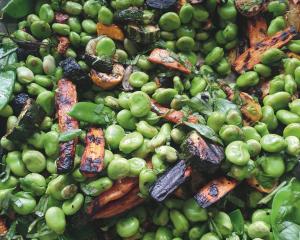
Tapenade, that powerful, piquant puree of black olives, capers, anchovies and herbs is the famous aromatic spread of Provence.
To mellow its potency a little, I have combined it with Puy lentils - the tiny, speckled, grey-green French lentils of exceptional quality.
Olives, capers and anchovies are all salty, so the addition of lentils helps reduce the saltiness of the tapenade considerably.
When pureeing the ingredients, the trick is not to pulverise everything to a smooth paste as this can make for a bitter-tasting spread.
Buying olives already pitted is not a good idea, as they have lost most of their flavour.
It's easy to pit an olive. Using a knife with a broad blade - a chef's knife is ideal - place the flat side of the blade on top of the olive and push down firmly. The olive will split and it is easy to remove the stone.
You will need about 160g of Kalamata olives, stone in, to give 120g of pitted olives.
Cooking the lentils until al dente can be tricky. They can go from firm to mushy quite quickly but this method of cooking, parboiling them very briefly before gently simmering in a well-flavoured liquid is virtually foolproof.
The end result is tender lentils, each one separate and holding its shape. These make a superb base for a variety of dishes, particularly salads.
Puy lentil tapenade
Makes almost 3 cups
Ingredients
250g Puy lentils
water
4 cloves garlic, peeled
5 bay leaves, preferably fresh
2 sprigs thyme
2 cups chicken or vegetable stock
½ cup water
3 Tbsp extra virgin olive oil
zest of a lemon
3 Tbsp lemon juice
3 Tbsp brandy
4-5 canned or bottled anchovy fillets
120g pitted Kalamata olives
3 Tbsp capers, rinsed and well drained
To cook the lentils
Put the lentils into a medium-sized saucepan and cover with plenty of cold water.
Bring to the boil over medium heat and simmer for one minute only. Drain well in a sieve and return lentils to the saucepan. Squash the garlic lightly with the blade of a knife to release its flavour during cooking. Add to the saucepan.
Bay leaves release their flavour best when torn. Make four tears in each leaf without severing the main vein and add to the saucepan. Add the thyme, stock and water and bring to a slow simmer over gentle heat and cook for 15-20 minutes (adding more water if the pan starts to dry out) until tender.
Drain into a sieve, discarding garlic, bay leaves and thyme stalks. Place the sieve containing the lentils over the saucepan and leave for 10 minutes to allow any moisture to evaporate off.
Place the lentils, olive oil, lemon zest, lemon juice and brandy in a food processor and process for about 30 seconds, scraping down the sides of the bowl several times. The mixture should be fairly smooth and not too thick.
Add the anchovies, olives and capers and pulse carefully several times until the anchovies, olives and capers are chopped into tiny pieces and well incorporated with the lentils but not completely pulverised. Spoon into an attractive serving dish, cover and refrigerate until required but bring to room temperature for serving. Tapenade will keep for four to five days in the fridge.
Little toasts
Serve spread on ''Little Toasts'' or French bread.
These little toasts create a lot of interest whenever I serve them.
Everyone asks what they are. Vogels make a bread called ''Very Thin'', and with a light spray of olive oil it oven bakes to a crisp, crunchy golden toast. Perfect for all manner of pates and spreads.
Method
Preheat the oven to 180degC. Line a baking tray with non-stick baking paper.
Trim the crusts from the bread and cut each slice into four squares or triangles. Place on the lined baking tray and lightly spray with olive oil.
Bake for 8-10 minutes, turn over, spray the other side and bake for about eight minutes more until lightly golden and crisp. Cool.
Store in an airtight tin. They will keep their crispness for several days but can be refreshed in a hot oven if they become stale.
Lentil facts
• Rich in dietary fibre
• High in protein especially green lentils
• Have high content of macronutirents such as folate, iron and phosphorus
• Grows in a bushy annual plant
• Plant about 40cm tall
• Seeds grown in pods usually with two seeds in each
• Le Puy green lentil is protected throughout the European Union according to its Protected Designation of Origin
• In the European Union, the term may only be used to designate lentils that come from the region of Le Puy in France.
Other uses for tapenade
• An extra flavour layer in your pie
• As a savoury filling in scrolls or brioche
• As a quick and tasty sauce for pasta
• A twist on a crust for fish












